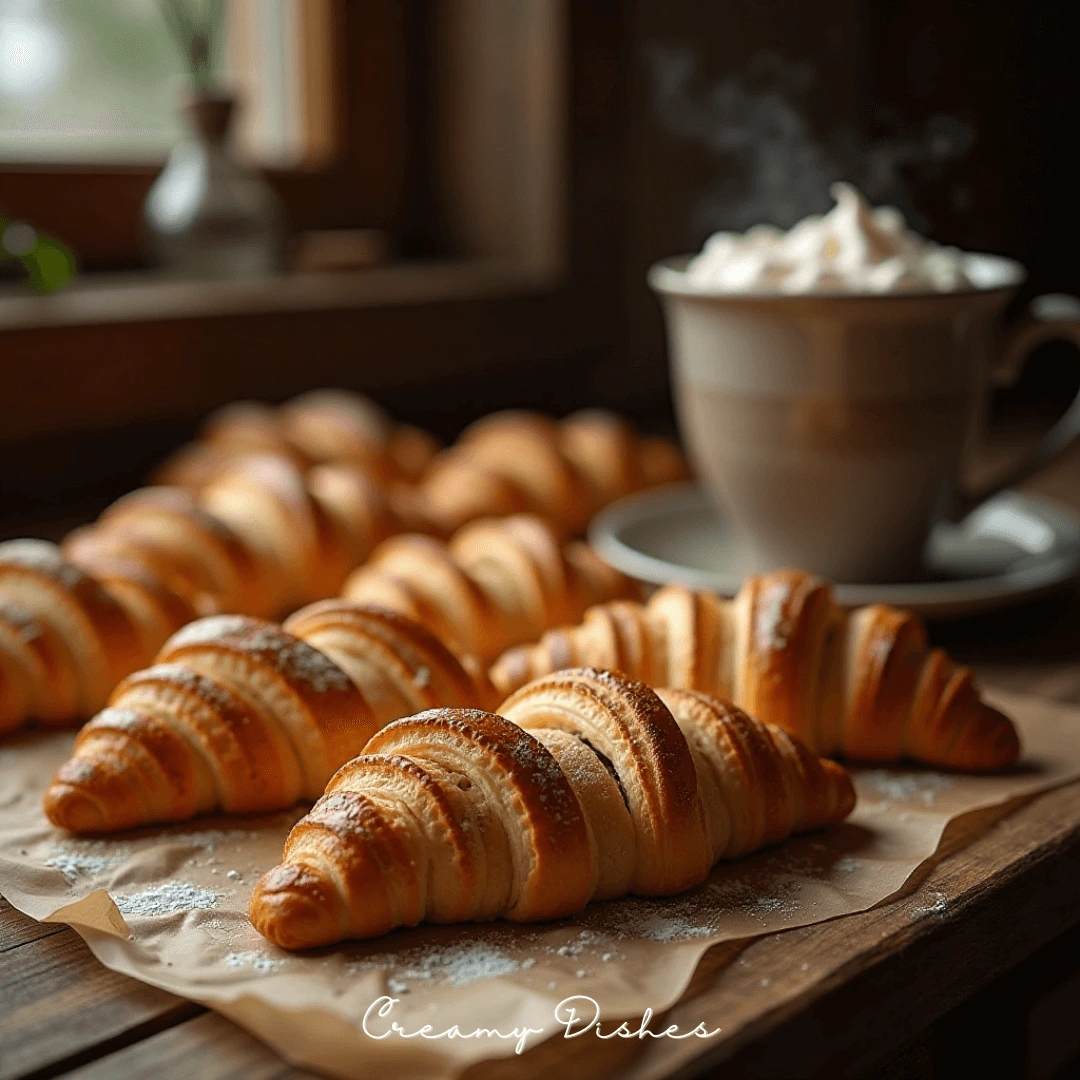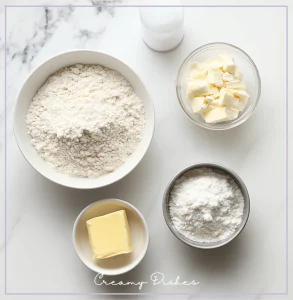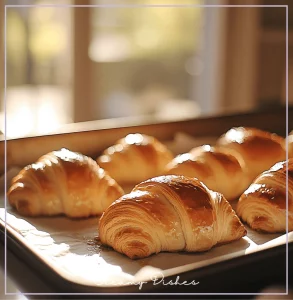The authentic Swiss Gipfeli recipe provides an excellent opportunity for those who enjoy buttery flaky pastries. When compared to French croissants Swiss Gipfeli offer density similar to traditional croissants and provide the same delightful eating experience.
The step-by-step guide in this article demonstrates the complete process of making Gipfeli using basic home cooking ingredients to get perfect flaky results.

Authentic Swiss Gipfeli
Ingredients
- 500 g all-purpose flour
- 10 g salt
- 50 g sugar
- 20 g fresh yeast or 7g dry yeast
- 300 ml lukewarm milk
- 250 g high-quality unsalted butter for layering
- 1 egg yolk + 2 tbsp milk for egg wash
Instructions
Preparing the Dough
- In a large bowl, mix flour, salt, and sugar.500 g all-purpose flour, 10 g salt, 50 g sugar

- Dissolve yeast in lukewarm milk and let it sit for 5 minutes.20 g fresh yeast, 300 ml lukewarm milk
- Gradually pour the milk mixture into the flour and knead until smooth.
- Cover the dough with a cloth and let it rest for 30 minutes.
Rolling and Folding the Butter
- Flatten the butter into a rectangular shape between two parchment sheets.

- Roll out the dough into a large rectangle and place the butter in the center.
- Fold the dough over the butter, sealing the edges completely.250 g high-quality unsalted butter
- Chill for 30 minutes before continuing with layering.
Creating Flaky Layers
- Roll the dough out into a long rectangle and fold it into thirds (like a letter).
- Chill for 30 minutes, then repeat the rolling and folding two more times.
- Let the dough rest in the refrigerator for at least 1 hour.
Shaping and Baking the Gipfeli
- Roll the dough into a large circle and cut it into triangles.
- Roll each triangle from the base to the tip to form the classic Gipfeli shape.
- Place on a baking sheet, brush with egg wash, and let them rise for 30 minutes.1 egg yolk + 2 tbsp milk
- Bake at 375°F (190°C) for 15-20 minutes, or until golden brown.

Notes
- Use High-Quality Butter for the Best Layers: The key to flaky Swiss Gipfeli is using high-fat butter, which enhances flavor and helps create perfect layers.
- Keep the Dough and Butter Cold: Always chill the dough and butter between folds to prevent the butter from melting into the dough.
- Roll the Dough Evenly: For consistent baking and perfect Gipfeli shapes, roll the dough evenly.
- Don’t Skip the Egg Wash: The egg wash gives the Gipfeli a shiny, golden crust.
- To Store: Keep in an airtight container at room temperature for up to 2 days or freeze for up to 3 months.
- To Reheat: Preheat oven to 350°F (175°C). Place Gipfeli on a baking tray and warm for 5-7 minutes.
Variations of Gipfeli Recipes You Must Try
Classic Butter Gipfeli
This conventional baking recipe delivers flavors with buttery richness and light flakey texture that results in beautiful mouthfuls.
Chocolate-Filled Gipfeli
Each Gipfeli gets its decadent surprise when you place a piece of dark chocolate inside before rolling it up.
Almond Croissant-Style Gipfeli
When the baked Gipfeli have cooled down you should apply almond syrup and finish with almond slices to make them taste even better.
Whole Wheat Gipfeli
The alternative to creating whole wheat versions involves using whole wheat flour as an equal substitute for regular flour. The addition of this basic modification enhances nutritional quality without changing the pleasant texture.

How to Store and Reheat Homemade Gipfeli
Storing Gipfeli for Freshness
Gipfelis should be stored in an air-tight container at room temperature for two days of freshness. Airtight ziplock bags allow you to freeze these Gipfeli for storage that extends up to three months.
How to Reheat Swiss Gipfeli
First, preheat the oven to 350°F (175°C). Place the Gipfeli that are frozen or room temperature directly onto a baking tray. Baking trays should receive the Gipfeli before placing them in the oven for a heat duration of 5-7 minutes.
Serve Them in This Way to Experience the Best Flavor
The partnership of Gipfeli with hot chocolate or vanilla custard creates a perfect combination that brings out superior flavor and texture appeal.
A Typical Swiss Breakfast Begins with Gipfeli Served Together with Either Nutritious Sweet Honey or Creamy Butter to Elevate Its Tasty Butter Notes.
Tips for Perfecting Your Flaky and buttery Swiss Gipfeli
The process of developing your Swiss Gipfeli can include both ingredient and method experimentation. Swiss Gipfeli becomes denser in texture when you swap half of the all-purpose flour with whole wheat flour in the recipe. The pastry will maintain a soft texture when you substitute part of the butter with less quantity in each layer to create less flakiness. Cultured butter offers tangy taste but altering salt levels is needed if you use salted butter.
A delightful change can be achieved by incorporating chocolate or almond paste inside the dough before you bake it. Each piece of this dessert brings unexpected indulgence to your taste. Escalated time constraints allow you to simplify the procedure by omitting layering and folding techniques and simply distributing butter in a single layer before wrapping dough. The simpler folding technique produces excellent results but the traditional layers create a superior flaky texture.
Avoiding Mistakes When Making Swiss Gipfeli
The process of learning how to make Swiss Gipfeli started with several initial mistakes which I later mastered to avoid common errors. The following steps proved essential for making outstanding Swiss Gipfeli.
The preservation of cold temperatures between dough and butter ensures layer formation since melted butter destroys the intended texture. The achievement of light airy layers depends on adequate proper rest for the dough. Dough rolling for uniformity leads to systematic baking and the egg wash produces shiny golden pastries that also enhance the crust richness. Be careful to limit your filling usage of chocolate and almond paste to avoid leakage that will result in soggy pastries. The implementation of these straightforward methods leads to beautiful and perfect results in your cooking process.
The recommended tips will help you achieve successful Swiss Gipfeli results with their perfect flakiness and buttery deliciousness. Learning how to bake these at home will require some practice yet mastering the techniques will result in professional-level baking abilities.
Nutrition Information of your Swiss Gipfeli (Per Serving)
- Serving Size: 1 Gipfeli
- Calories: 250 kcal
- Sugar: 3g
- Sodium: 180mg
- Fat: 14g
- Saturated Fat: 8g
- Unsaturated Fat: 5g
- Trans Fat: 0g
- Carbohydrates: 27g
- Fiber: 1g
- Protein: 5g
- Cholesterol: 45mg

Your expertise in producing buttery Swiss Gipfeli allows you to move forward with baking homemade versions. Homemade pastries from the traditional recipe together with chocolate and almond variations will surely amaze everyone who tries them.
A combination of rich and creamy dishes makes a perfect match for your Gipfeli resulting in an absolute indulgent delight. With that in mind, happy baking!
FAQ
What are the different types of gipfeli?
Gipfeli stands as the Swiss name for croissants worldwide although Switzerland produces multiple versions of this baked pastry product. Despite their common flaky texture both gipfeli and croissants possess distinct preparation as well as flavor characteristics.
The classic gipfeli stands as one of the most frequent choices among the various croissant editions known in Switzerland. The buttery dough creates a gipfeli version with a firm exterior combined with tender inside. Swiss people usually consume this pastry during their morning meals but also eat it as a light snack which pairs well with butter or cheese.
What is the German version of a croissant?
The German version of the croissant is the gipfeli, especially in Switzerland, where this term is equivalent to the croissant. While in Germany, terms like “hörnchen” are more commonly used, gipfeli remains very popular and is enjoyed in a similar way, often with various fillings and combinations. The basic recipe is quite similar to that of a croissant, but it tends to have a slightly denser texture, which sets it apart from the French version.
Do the French put butter on their croissants?
Most French people consume their fresh croissants with butter while these pastries are available along with hot drinks at traditional cafés. The process of placing butter on croissants for baking occurs frequently but does not happen in every baking procedure. Each person receives their croissant alongside butter when servers set the pastry before baking. Then people can add butter according to personal preference. The delicious combination occurs when the velvety soft butter joins the crisp and flaky croissant structure.
Keywords: Swiss pastry, flaky croissants, buttery breakfast pastries, homemade Swiss Gipfeli, easy croissant recipe, traditional Swiss breakfast
You May Also Like:





3 thoughts on “Flaky and buttery Swiss Gipfeli Recipe to Bake at Home Easily”